Monthly Archives: April 2017
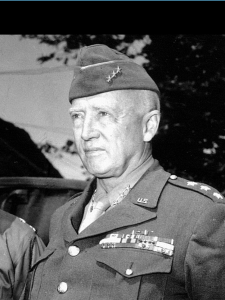 In many of the wars there have been in our world, one thing seems to be a constant…the atrocities against prisoners of war, and even the citizens of the evil nations we are fighting against. World War II probably saw some of the worst atrocities, during the Holocaust. It was during that time that prison camps like Auschwitz-Birkenau, Buchenwald, Chelmno, Dachau, and Terezin, just to name a few, were used either for the murder of Jews and anyone else Hitler felt was not of the standard of people he thought they should be, or the prisoners they held were used as forced labor.
In many of the wars there have been in our world, one thing seems to be a constant…the atrocities against prisoners of war, and even the citizens of the evil nations we are fighting against. World War II probably saw some of the worst atrocities, during the Holocaust. It was during that time that prison camps like Auschwitz-Birkenau, Buchenwald, Chelmno, Dachau, and Terezin, just to name a few, were used either for the murder of Jews and anyone else Hitler felt was not of the standard of people he thought they should be, or the prisoners they held were used as forced labor.
Buchenwald was not an Annihilation camp, but that doesn’t mean that it was a easy existence. The Germans were not good to their prisoners. Prisoners from all over Europe and the Soviet Union…Jews, Poles and other Slavs, the mentally ill and physically-disabled from birth defects, religious and political prisoners, Roma and Sinti, Freemasons, Jehovah’s Witnesses (then called Bible Students), criminals, homosexuals, and prisoners of war, worked primarily as forced labor in local armaments factories. It seems as if there were no groups who were exempt. If they didn’t fit into Hitler’s mold, they were contained in the camps, or killed. Buchenwald concentration camp (German: Konzentrationslager, which in English, literally means beech forest) was a German Nazi concentration camp established on the Ettersberg (Etter Mountain) near Weimar, Germany, in July 1937. It was one of the first and the largest of the concentration camps on German soil, following Dachau’s opening just over four years earlier.
On April 11, 1945, four soldiers in the Sixth Armored Division of the US Third Army, commanded by General 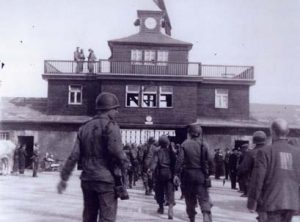 George S Patton, liberated the Buchenwald concentration camp. Just before the Americans arrived, the camp had already been taken over by the Communist prisoners who had killed some of the guards and forced the rest to flee into the nearby woods. They knew the end was near for them anyway, and there seemed no further reason to stand and fight. I suppose that the fact that the guards had deserted their posts, made it possible for just four soldiers to take over and liberate the camp. On the morning of April 12, 1945, soldiers of the 80th Infantry Division arrived in the nearby town of Weimar and found it deserted except for some of the liberated prisoners roaming around. The townspeople were cowering in fear inside their homes…bomb-damaged from the February 9, 1945 air raid that was to precede the liberation process. I would think that if any of them were a part of the concentration camp, there would be reason to fear the prisoners in town, because they had a reason to kill them, after all they had been through in German custody.
George S Patton, liberated the Buchenwald concentration camp. Just before the Americans arrived, the camp had already been taken over by the Communist prisoners who had killed some of the guards and forced the rest to flee into the nearby woods. They knew the end was near for them anyway, and there seemed no further reason to stand and fight. I suppose that the fact that the guards had deserted their posts, made it possible for just four soldiers to take over and liberate the camp. On the morning of April 12, 1945, soldiers of the 80th Infantry Division arrived in the nearby town of Weimar and found it deserted except for some of the liberated prisoners roaming around. The townspeople were cowering in fear inside their homes…bomb-damaged from the February 9, 1945 air raid that was to precede the liberation process. I would think that if any of them were a part of the concentration camp, there would be reason to fear the prisoners in town, because they had a reason to kill them, after all they had been through in German custody.
Recently, I found out that General George S Patton was my 8th cousin twice removed, on my grandmother, Hattie Pattan Byer’s side. I had always suspected a relationship there, with my grandmother’s maiden name being Pattan, but I didn’t expect it in the way it came about, since it is from my grandmother Elizabeth Shuck, who married my grandfather David Pattan, and not from the Pattan side outright. I have always liked General 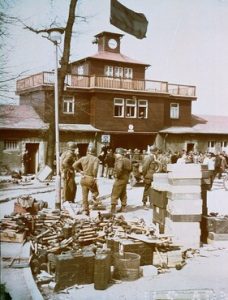 Patton, and I think it is really awesome that he is related to my family. In my opinion, he was an amazing general. He served as a commissioned officer in the United States Army for 36 years. He served in three major conflicts (Mexican Punitive Expedition, World War I and World War II) during his military career. He was awarded with the Distinguished Service Cross with one oak leaf cluster, the Army Distinguished Service Medal with two oak leaf clusters, the Navy Distinguished Service Medal, the Silver Star with one oak leaf cluster, the Legion of Merit, the Bronze Star Medal, the Purple Heart, the Silver Lifesaving Medal, the Mexican Border Service Medal, the World War I Victory Medal with four bronze campaign stars, the American Defense Service Medal, the European-African-Middle Eastern Campaign Medal with one silver and two bronze campaign star, the World War II Victory Medal, and posthumously…the Army of Occupation Medal with Germany clasp. That’s quite a war record. I’m sure the prisoners that he liberated felt that he very much earned them for his war skills.
Patton, and I think it is really awesome that he is related to my family. In my opinion, he was an amazing general. He served as a commissioned officer in the United States Army for 36 years. He served in three major conflicts (Mexican Punitive Expedition, World War I and World War II) during his military career. He was awarded with the Distinguished Service Cross with one oak leaf cluster, the Army Distinguished Service Medal with two oak leaf clusters, the Navy Distinguished Service Medal, the Silver Star with one oak leaf cluster, the Legion of Merit, the Bronze Star Medal, the Purple Heart, the Silver Lifesaving Medal, the Mexican Border Service Medal, the World War I Victory Medal with four bronze campaign stars, the American Defense Service Medal, the European-African-Middle Eastern Campaign Medal with one silver and two bronze campaign star, the World War II Victory Medal, and posthumously…the Army of Occupation Medal with Germany clasp. That’s quite a war record. I’m sure the prisoners that he liberated felt that he very much earned them for his war skills.
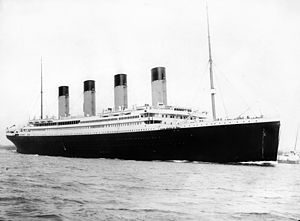 On this, the 105 anniversary of the April 10, 1912 sailing of the RMS Titanic, for her maiden and only voyage, my thoughts have been leaning toward the people who were on board, and particularly those who did not survive that fateful trip. The Titanic was the most amazing ship of it’s time, filled with luxuries beyond the imagination…at least in first class. Back then, people were separated into classes based on their social importance. It’s sad to think about that, because every person has value, and many of those in 3rd class, or steerage were considered expendable. Nevertheless, it was not just those in steerage who lost their lives when Titanic went down on April 12th, 1912.
On this, the 105 anniversary of the April 10, 1912 sailing of the RMS Titanic, for her maiden and only voyage, my thoughts have been leaning toward the people who were on board, and particularly those who did not survive that fateful trip. The Titanic was the most amazing ship of it’s time, filled with luxuries beyond the imagination…at least in first class. Back then, people were separated into classes based on their social importance. It’s sad to think about that, because every person has value, and many of those in 3rd class, or steerage were considered expendable. Nevertheless, it was not just those in steerage who lost their lives when Titanic went down on April 12th, 1912.
As Titanic set sail on April 10th, here was much excitement. Those who were “lucky” enough to have secured passage, were to be envied. Of course, the rich and famous had no trouble paying for their passage, but the less fortunate had a different situation, and different accommodations. Many of the steerage passengers had spent their last penny to pay for their passage, and still they considered it money well spent, because they were heading to America for a better life. Little did any of the passengers in all three classes know that in just two days, their beautiful ship would be at the bottom of the ocean, along with many of her passengers and crew. It is here that I began to wonder what they were thinking as the ship sank beneath their feet, into the deep dark 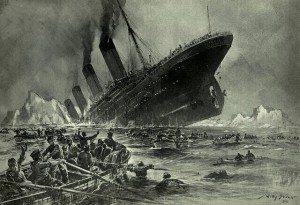 murky depths. I know most of them were just trying to find a way to get onto one of the life boats…of which there were too few by at least half, but did it also become that moment when they thought about what might have been for them…had they not taken this particular trip, on this particular ship. I think that anytime a person finds themselves faced with death, their thoughts turn to family, friends, and what might have been. Most luxury trips taken are for a few reasons…among them the scenery, a long awaited visit, or just the sheer luxury of this particular type of trip. No one really considers what might happen if things go wrong, or at the very least, we try not to think about it. Still, when the moment of emergency arrives, did the passengers of Titanic think that if only they had waited for Titanic’s next trip, they wouldn’t be here today…in this most horrible of situations, with so many others screaming in fear, because they knew they were about to die…unless a miracle happened for them.
murky depths. I know most of them were just trying to find a way to get onto one of the life boats…of which there were too few by at least half, but did it also become that moment when they thought about what might have been for them…had they not taken this particular trip, on this particular ship. I think that anytime a person finds themselves faced with death, their thoughts turn to family, friends, and what might have been. Most luxury trips taken are for a few reasons…among them the scenery, a long awaited visit, or just the sheer luxury of this particular type of trip. No one really considers what might happen if things go wrong, or at the very least, we try not to think about it. Still, when the moment of emergency arrives, did the passengers of Titanic think that if only they had waited for Titanic’s next trip, they wouldn’t be here today…in this most horrible of situations, with so many others screaming in fear, because they knew they were about to die…unless a miracle happened for them.
Titanic was carrying 2,222 people (passengers and crew), when she set sail. Of those people only 706 would receive that miracle. For the rest, this would be the end of their life. Of the 706 survivors, 492 were passengers, and 214 were crew members, a fact that I find rather odd. The class distinctions were closer to expected, with 61% of first class passengers surviving, 42% of second class passengers surviving, and 24% of third class passengers surviving. That is a sad reality of a time when class was everything. I’m sure that all of 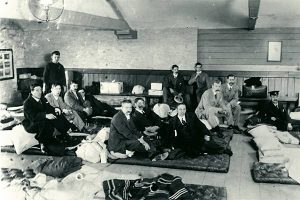 these people felt that their lives were a tremendous gift, and I’m sure too that their lives changed in a big way. Still, I wonder about the final thoughts of the 1516 people who died that day. I’m sure they wished they had not taken the trip, and I’m sure that they regretted the fact that their family would be sad. It really doesn’t matter what they were thinking, I guess, because it was too late to change what was…for most of them anyway. For the holder of Ticket number 242154, it appears that it was not to late. The holder of that ticket is unknown, but they were given a full refund for their ticket, and it appears that they did not sail on Titanic. Perhaps, they had their ear to the Lord’s Word, and were told not to sail. Not knowing who this person was, we will never know for sure.
these people felt that their lives were a tremendous gift, and I’m sure too that their lives changed in a big way. Still, I wonder about the final thoughts of the 1516 people who died that day. I’m sure they wished they had not taken the trip, and I’m sure that they regretted the fact that their family would be sad. It really doesn’t matter what they were thinking, I guess, because it was too late to change what was…for most of them anyway. For the holder of Ticket number 242154, it appears that it was not to late. The holder of that ticket is unknown, but they were given a full refund for their ticket, and it appears that they did not sail on Titanic. Perhaps, they had their ear to the Lord’s Word, and were told not to sail. Not knowing who this person was, we will never know for sure.
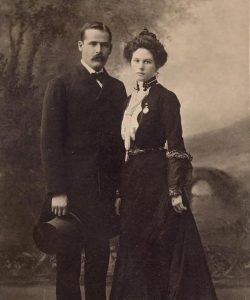 Over the years, many have speculated about the validity of the death of famous people, among them, Elvis Presley. For some unknown reason, people just cant believe, for whatever reason, that someone famous is dead. Butch Cassidy and the Sundance Kid were legendary outlaws who robbed trains, payroll couriers, and banks. When the law got too close to them, they took off for Bolivia. It wasn’t a plan that fared well…or was it? Robert Leroy Parker was born April 13, 1866, in Beaver, Utah. As a bandit, he used the alias Butch Cassidy. Harry Alonzo Longabaugh born in Mont Clare, Pennsylvania in 1867, was better known as Butch Cassidy’s sidekick and partner in crime, the Sundance Kid. The two of them had an illustrious criminal career, but as with all criminal careers, at some point mistakes are made, or they meet their match in a lawman who bests them, with a gun or their abilities as a detective. A part of the Wild Bunch, the careers of Butch Cassidy and the Sundance Kid were shrouded in mystery, but that mystery pales by comparison to their deaths. After making their escape to Argentina, and then to Bolivia, Cassidy, the Kid, and girlfriend, Etta Place thought that the small town of San Vicente would be an easy target for their crimes.
Over the years, many have speculated about the validity of the death of famous people, among them, Elvis Presley. For some unknown reason, people just cant believe, for whatever reason, that someone famous is dead. Butch Cassidy and the Sundance Kid were legendary outlaws who robbed trains, payroll couriers, and banks. When the law got too close to them, they took off for Bolivia. It wasn’t a plan that fared well…or was it? Robert Leroy Parker was born April 13, 1866, in Beaver, Utah. As a bandit, he used the alias Butch Cassidy. Harry Alonzo Longabaugh born in Mont Clare, Pennsylvania in 1867, was better known as Butch Cassidy’s sidekick and partner in crime, the Sundance Kid. The two of them had an illustrious criminal career, but as with all criminal careers, at some point mistakes are made, or they meet their match in a lawman who bests them, with a gun or their abilities as a detective. A part of the Wild Bunch, the careers of Butch Cassidy and the Sundance Kid were shrouded in mystery, but that mystery pales by comparison to their deaths. After making their escape to Argentina, and then to Bolivia, Cassidy, the Kid, and girlfriend, Etta Place thought that the small town of San Vicente would be an easy target for their crimes.
As courier for the Aramayo, Francke and Cia mining company, Carlos Pero was riding his mule up a rugged trail high in the Andes Mountains on the morning of November 4, 1908. He was completely unaware that his every move was being watched. Pero later said that after cresting a hill, he was “surprised by two Yankees, whose faces were covered with bandanas and whose rifles were cocked and ready to fire.” The pair of masked bandits robbed the courier of the company’s payroll and then disappeared into the desolation of southern Bolivia, but that was not to be the end of it. Three days later, four Bolivian officers cornered a pair of Americans suspected of being the bandits in a rented house, in the dusty village of San Vicente. The Pinkerton Detective Agency, which had long been trailing Butch Cassidy and the Sundance Kid, and had warned banks across South America to be on the lookout for them, because they had fled there from the United States in 1901. It was 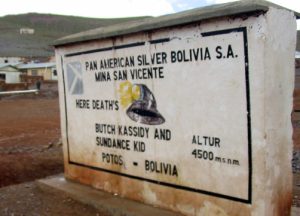 reported that the two Americans holed up in San Vicente were them. As a Bolivian soldier approached the hideout, the Americans shot him dead. A brief exchange of gunfire ensued. When it was over, San Vicente mayor Cleto Bellot reported hearing “three screams of desperation” followed by two gunshots from inside the house. When the Bolivian authorities cautiously entered the hideout the following morning, they found the bodies of the two foreigners.
reported that the two Americans holed up in San Vicente were them. As a Bolivian soldier approached the hideout, the Americans shot him dead. A brief exchange of gunfire ensued. When it was over, San Vicente mayor Cleto Bellot reported hearing “three screams of desperation” followed by two gunshots from inside the house. When the Bolivian authorities cautiously entered the hideout the following morning, they found the bodies of the two foreigners.
For decades, Daniel Buck and Anne Meadows, husband and wife researchers scoured South American archives and police reports trying to track down the true story of what happened to Butch Cassidy and the Sundance Kid, a saga that Meadows detailed in her book “Digging up Butch and Sundance.” While the paper trail pointed to their deaths in Bolivia, conclusive evidence as to the identities of the bandits killed in San Vicente in November 1908 rested under the ground of the village’s cemetery. The researchers enlisted the help of Clyde Snow, the renowned forensic anthropologist who had conclusively identified the remains of Nazi war criminal Josef Mengele. They received permission from Bolivian authorities to exhume the robbers’ bodies. Guided to their purported grave by an elderly villager whose father had reportedly witnessed the shootout, they opened the graves in 1991. Inside they found a skeleton of one man, and a piece of a skull from another. After a detailed forensic analysis and a comparison of DNA to the relatives of Cassidy and Longabaugh, Snow found there was no match. The skeleton was instead likely to have been that of a German miner named Gustav Zimmer who had worked in the area. It’s possible that the bodies of the iconic outlaws remain buried elsewhere in the San Vicente cemetery or even elsewhere in the country, but with no conclusive proof as to the whereabouts of the bodies of Butch Cassidy and the Sundance Kid, their ultimate fate remains a mystery.
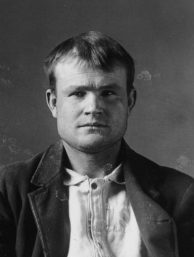
With no conclusive evidence to confirm the deaths of Butch Cassidy and the Sundance Kid, the rumors flew, that the pair had once again eluded the long arm of the law, and sightings of the duo in South America, Mexico and the United States continued for decades to come. Family members fueled the stories by insisting that the men had never been killed and instead returned to the United States to live into old age. Cassidy’s sister, Lula Parker Betenson, wrote in her 1975 book “Butch Cassidy, My Brother” that the outlaw had returned to the family ranch in Circleville, Utah, in 1925 to visit his ailing father and attend a family wedding. According to Betenson, Cassidy told the family that a friend of his had planted the story that one of the men killed in Bolivia was him so that he would no longer be pursued. She claimed that Cassidy lived in the state of Washington under an alias until his death in 1937. Betenson said her brother was buried in an unmarked grave in a location that was kept a family secret.
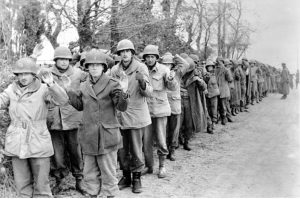 For as long as there have been wars, there have been prisoners of war. Obviously, part of the reason was to take those soldiers out of the fighting. If you are fighting against less enemy combatants, you have a better change of winning. It was a simply a part of war. Both sided took prisoners, and both sides knew that the other side was going to take prisoners. It was not the fact that prisoners were taken, but rather the way they were treated that made this part of war ugly sometimes.
For as long as there have been wars, there have been prisoners of war. Obviously, part of the reason was to take those soldiers out of the fighting. If you are fighting against less enemy combatants, you have a better change of winning. It was a simply a part of war. Both sided took prisoners, and both sides knew that the other side was going to take prisoners. It was not the fact that prisoners were taken, but rather the way they were treated that made this part of war ugly sometimes.
I’m sure that if there was work to do, it made sense to use the prisoners of war 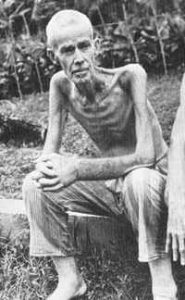 as, basically slave labor…make them earn their keep, so to speak, but often they were beaten, starved, overworked to the point of exhaustion, and basically treated like they were sub-human. Some nations were worse than others. And sometimes, the prisoners of war, weren’t even combatants, but civilians taken hostage for a variety of reasons…most of which had nothing to do with them being a danger in battle. Of course, from about the time of the Vietnam war, it became harder to tell if someone was a “combatant” or not. When children were sent out to interact with soldiers…bombs strapped to their chest…soldiers had to learn to be less than hospitable to the little ones too.
as, basically slave labor…make them earn their keep, so to speak, but often they were beaten, starved, overworked to the point of exhaustion, and basically treated like they were sub-human. Some nations were worse than others. And sometimes, the prisoners of war, weren’t even combatants, but civilians taken hostage for a variety of reasons…most of which had nothing to do with them being a danger in battle. Of course, from about the time of the Vietnam war, it became harder to tell if someone was a “combatant” or not. When children were sent out to interact with soldiers…bombs strapped to their chest…soldiers had to learn to be less than hospitable to the little ones too.
I understand the need for prisoners of war, when the war is still going on, but what is appalling is the treatment of the prisoners sometimes, and the refusal to give the prisoners back at the end of the conflict. Vietnam was also one of the times when prisoners were held long after the war. I know that sometimes the reasons for holding prisoners is that the opposing government refuses to abide by the conditions of the 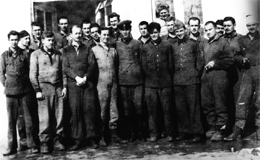 surrender of the losing side. Still, sometimes, the prisoners were held, for no legitimate reason, and for far longer than was reasonable. After World War II, the western Allies released their final prisoners in 1948, but many German POWs in the USSR were held for several more years. Most were used as slave labor in copper or coal mines, and anywhere between 400,000, and up to one million eventually died while in Russian custody. Some 20,000 former soldiers were still in Soviet hands at the time of Joseph Stalin’s death in 1953, and the last 10,000 didn’t get their freedom until 1955 and 1956 a full decade after the war had ended. That seems completely unconscionable to me, but then I’m not part of an evil nation.
surrender of the losing side. Still, sometimes, the prisoners were held, for no legitimate reason, and for far longer than was reasonable. After World War II, the western Allies released their final prisoners in 1948, but many German POWs in the USSR were held for several more years. Most were used as slave labor in copper or coal mines, and anywhere between 400,000, and up to one million eventually died while in Russian custody. Some 20,000 former soldiers were still in Soviet hands at the time of Joseph Stalin’s death in 1953, and the last 10,000 didn’t get their freedom until 1955 and 1956 a full decade after the war had ended. That seems completely unconscionable to me, but then I’m not part of an evil nation.
 When a child is born, their parents have high hopes for the baby’s life, not knowing anything about the child yet, or what talents he or she might have. As the years go by, the parents begin to notice different aspects of this new little person, and get little hints about their interests. Still, they don’t really know who this child will become. That part of their child is still in the future, and what they will be, remains to be seen. It always seems like it is so far in the future, but in fact, it isn’t. It will seem like just yesterday that you wondered who this child would be, and suddenly, they know.
When a child is born, their parents have high hopes for the baby’s life, not knowing anything about the child yet, or what talents he or she might have. As the years go by, the parents begin to notice different aspects of this new little person, and get little hints about their interests. Still, they don’t really know who this child will become. That part of their child is still in the future, and what they will be, remains to be seen. It always seems like it is so far in the future, but in fact, it isn’t. It will seem like just yesterday that you wondered who this child would be, and suddenly, they know.
That is the case with my niece, Chantel Balcerzak. When she was a little girl, she was such a little Diva, and trust me when I say that she is still a classy looking lady, but  there is so much more to the person that Chantel has grown up to be than that little pretty lady she always was. Chantel’s artistic talents started to shine through early on. She loves to write, decorate, refurbish furniture, and paint…and I, for one, have been the recipient of several of her designs. These days, Chantel’s interests have turned to wedding planning. She has started a Facebook site called Next To The Dress, and she is very good at what she does. I love her ideas, as do the brides and grooms she has helped to achieve their perfect day. She is able to plan any style of wedding, and she makes them absolutely beautiful. I just love Chantel’s creativity. I could never put together the things that she does…both in her weddings and her hobbies. I think that one of the main reasons that Chantel is so good at what she does, is because of her genuinely caring heart. I think it would be unthinkable for Chantel to
there is so much more to the person that Chantel has grown up to be than that little pretty lady she always was. Chantel’s artistic talents started to shine through early on. She loves to write, decorate, refurbish furniture, and paint…and I, for one, have been the recipient of several of her designs. These days, Chantel’s interests have turned to wedding planning. She has started a Facebook site called Next To The Dress, and she is very good at what she does. I love her ideas, as do the brides and grooms she has helped to achieve their perfect day. She is able to plan any style of wedding, and she makes them absolutely beautiful. I just love Chantel’s creativity. I could never put together the things that she does…both in her weddings and her hobbies. I think that one of the main reasons that Chantel is so good at what she does, is because of her genuinely caring heart. I think it would be unthinkable for Chantel to  have a wedding go bad…not because she planned it, but because it wouldn’t be…perfect for the bride and groom.
have a wedding go bad…not because she planned it, but because it wouldn’t be…perfect for the bride and groom.
I don’t know what Chantel’s mom, my sister, Cheryl Masterson thought she would become, but I know that she is very happy with the outcome. When a child is born, we know that they are an unwritten book, waiting to fill the pages with the wonderful choices they can make. I think Chantel has written a beautiful book of life for herself, and I am glad that I got to be a part of watching her become the beautiful woman she is….even if she is still a “little” lady. Today is Chantel’s birthday. Happy birthday Chantel!! Have a great day!! We love you!!
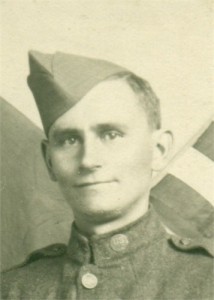 The United States is often called the Sleeping Giant. In the past, the United States has been known as the most powerful country in the world…back in the good old days, that is. Now China, Japan and Russia are also considered to be powerful countries where nuclear weaponry is concerned. The dollar was also the powerful currency, then and even now. The president of the United States was always considered the most powerful person, and I think still is today, or is moving back into that position. All these things considered, the United States was definitely a sleeping giant, because if it woke up it would do everything in its power to rectify things around the globe. As we saw on September 11, 2001, when terrorists attacked our country. Like Toby Keith sang in his song Courtesy Of The Red, White, And Blue (The Angry American), “Justice will be served, and the battle will rage. This big dog will fight when you rattle his cage. And you’ll be sorry that you messed with the U.S. of A” That is notoriously the way the United States has been when it comes to world conflict…slow to anger, but once we are in a war…we are in it to win it!
The United States is often called the Sleeping Giant. In the past, the United States has been known as the most powerful country in the world…back in the good old days, that is. Now China, Japan and Russia are also considered to be powerful countries where nuclear weaponry is concerned. The dollar was also the powerful currency, then and even now. The president of the United States was always considered the most powerful person, and I think still is today, or is moving back into that position. All these things considered, the United States was definitely a sleeping giant, because if it woke up it would do everything in its power to rectify things around the globe. As we saw on September 11, 2001, when terrorists attacked our country. Like Toby Keith sang in his song Courtesy Of The Red, White, And Blue (The Angry American), “Justice will be served, and the battle will rage. This big dog will fight when you rattle his cage. And you’ll be sorry that you messed with the U.S. of A” That is notoriously the way the United States has been when it comes to world conflict…slow to anger, but once we are in a war…we are in it to win it!
The same held true for the other wars we have been in. We might not jump in early, but when we do…look out. On this day, April 6, 1917, the United States Senate voted 82 to 6 to declare war against Germany, the United 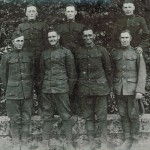 States House of Representatives endorses the declaration by a vote of 373 to 50, and America formally entered World War I. This action would be the one that would send my grandfather, George Byer to war. He was 24 years old. Grandpa didn’t talk much about his time in the war…at least not that I remember. I think that most of the men who came home after fighting in a war, are just happy to be home. They want to put it all behind them, and move forward with their lives, knowing that if it was ever necessary he would go back again. He was a patriot, and that was what patriots did. In fact, when the time came for the men to register for the “old man draft” of World War II…a time when men up to the age of 65 were required to register for the draft, Grandpa was honored to register, as were the other men between the ages of 45 and 65. These men felt like their time of usefulness was over, and when they were told that they were needed again, even if it was just for work on the home front, they all jumped at the chance to serve.
States House of Representatives endorses the declaration by a vote of 373 to 50, and America formally entered World War I. This action would be the one that would send my grandfather, George Byer to war. He was 24 years old. Grandpa didn’t talk much about his time in the war…at least not that I remember. I think that most of the men who came home after fighting in a war, are just happy to be home. They want to put it all behind them, and move forward with their lives, knowing that if it was ever necessary he would go back again. He was a patriot, and that was what patriots did. In fact, when the time came for the men to register for the “old man draft” of World War II…a time when men up to the age of 65 were required to register for the draft, Grandpa was honored to register, as were the other men between the ages of 45 and 65. These men felt like their time of usefulness was over, and when they were told that they were needed again, even if it was just for work on the home front, they all jumped at the chance to serve.
As for World War I, Grandpa would serve, and he would come home. Then, he would go on to live a long life…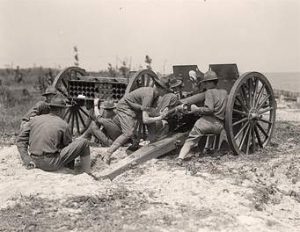 forever changed from the man he once was, because you see, war changes a man. They are changed by what they see, whether they were required to take a life or not. And if they were required to kill, then kill they would, because The Sleeping Giant had been awakened, and the Big Dog’s cage had been rattled. The United States would go to war, and they would win, along with their alleys, because losing was not an option…not if the world was to remain the kind of place we knew and loved. Germany was an evil empire, and that evil empire had to be stopped. I am very proud of my grandfather’s service, and I’m thankful that the Big Dog fought in this one and the other wars it has fought in. It was an important fight, and we needed to win it.
forever changed from the man he once was, because you see, war changes a man. They are changed by what they see, whether they were required to take a life or not. And if they were required to kill, then kill they would, because The Sleeping Giant had been awakened, and the Big Dog’s cage had been rattled. The United States would go to war, and they would win, along with their alleys, because losing was not an option…not if the world was to remain the kind of place we knew and loved. Germany was an evil empire, and that evil empire had to be stopped. I am very proud of my grandfather’s service, and I’m thankful that the Big Dog fought in this one and the other wars it has fought in. It was an important fight, and we needed to win it.
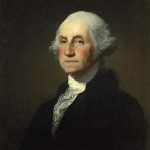 For anyone who has watched the process of getting a bill made law in Congress, the word Veto is a well known word. If the president doesn’t like the bill, he can always threaten to veto it, forcing Congress to get a two-thirds majority vote in both the House of Representatives and in the Senate to override his presidential veto. The exact number depends on how many representatives vote, so the actual number is subject to change. The word veto is Latin for I forbid, and it is the power used to unilaterally stop an official action, especially the enactment of legislation. Therefore, if the president doesn’t like the bill, even if it has passed the House and Senate, he can veto it to see if he can keep it from being passed on a second vote.
For anyone who has watched the process of getting a bill made law in Congress, the word Veto is a well known word. If the president doesn’t like the bill, he can always threaten to veto it, forcing Congress to get a two-thirds majority vote in both the House of Representatives and in the Senate to override his presidential veto. The exact number depends on how many representatives vote, so the actual number is subject to change. The word veto is Latin for I forbid, and it is the power used to unilaterally stop an official action, especially the enactment of legislation. Therefore, if the president doesn’t like the bill, even if it has passed the House and Senate, he can veto it to see if he can keep it from being passed on a second vote.
The first veto ever exercised was by President George Washington on April 5, 1792. The bill introduced a new plan for dividing seats in the House of Representatives that would have increased the amount of seats for northern states. After consulting with his politically divided and contentious cabinet, President Washington, who came from the southern state of Virginia, ultimately decided that the plan was unconstitutional because it provided for additional representatives for some states, and it would have introduced a number of representatives higher than that allowed by the Constitution. After a discussion with 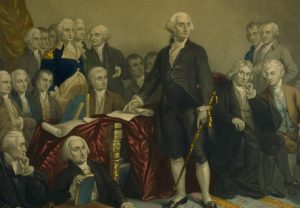 the president, Thomas Jefferson wrote in a letter that votes for or against the bill were divided along perfectly geographical lines between the North and South. Jefferson observed that Washington feared that a veto would incorrectly portray him as biased toward the South. In the end, Jefferson was able to convince the president to veto the bill on the grounds that it was unconstitutional and introduced principles that were liable to be abused in the future. Jefferson suggested apportionment instead be derived from “arithmetical operation, about which no two men can ever possibly differ.” With Washington’s veto, the bill was sent back to Congress. Though representatives could have attempted to overrule the veto with a two-thirds vote, Congress instead threw out the original bill and instituted a new one that apportioned representatives at “the ratio of one for every thirty-three thousand persons in the respective States.” That is a much more fair plan, in my opinion. George Washington would go on to veto one more bill during his time in office. In February 1797, the former commanding general of the Continental Army vetoed an act that would have reduced the number of cavalry units in the army. Neither of the vetoes were overridden by Congress.
the president, Thomas Jefferson wrote in a letter that votes for or against the bill were divided along perfectly geographical lines between the North and South. Jefferson observed that Washington feared that a veto would incorrectly portray him as biased toward the South. In the end, Jefferson was able to convince the president to veto the bill on the grounds that it was unconstitutional and introduced principles that were liable to be abused in the future. Jefferson suggested apportionment instead be derived from “arithmetical operation, about which no two men can ever possibly differ.” With Washington’s veto, the bill was sent back to Congress. Though representatives could have attempted to overrule the veto with a two-thirds vote, Congress instead threw out the original bill and instituted a new one that apportioned representatives at “the ratio of one for every thirty-three thousand persons in the respective States.” That is a much more fair plan, in my opinion. George Washington would go on to veto one more bill during his time in office. In February 1797, the former commanding general of the Continental Army vetoed an act that would have reduced the number of cavalry units in the army. Neither of the vetoes were overridden by Congress.
 Thirty six of the 45 presidents have vetoed at least one bill, with the most regular vetoes going to Franklin D Roosevelt with 372…seconded by Grover Cleveland with 346. There is also something called a pocket veto, which is basically when the president simply does nothing…refusing to sign it into law, or to veto it outright, and it was used by a number of presidents as well. That one seems strange to me, but it seems to have the same procedure to pass the bill into law that the regular veto does. Politics is a messy business, because with so many people involved, there is bound to be differing opinions on what should be done. Nevertheless, try as he might, while the buck might stop at the president’s office, the bill might not, but only if Congress can get its collective act together and vote to override a presidential veto.
Thirty six of the 45 presidents have vetoed at least one bill, with the most regular vetoes going to Franklin D Roosevelt with 372…seconded by Grover Cleveland with 346. There is also something called a pocket veto, which is basically when the president simply does nothing…refusing to sign it into law, or to veto it outright, and it was used by a number of presidents as well. That one seems strange to me, but it seems to have the same procedure to pass the bill into law that the regular veto does. Politics is a messy business, because with so many people involved, there is bound to be differing opinions on what should be done. Nevertheless, try as he might, while the buck might stop at the president’s office, the bill might not, but only if Congress can get its collective act together and vote to override a presidential veto.
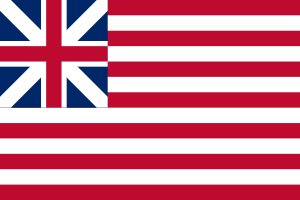 With the American flag at the center of so many protests, it seemed to me a good time to discuss the flag that many, and I believe truly most, Americans hold so dear. Over the years that the United states has been a nation, there have been a number of different flags. As we grew, the flag had to change to show the growing number of states. There were people who were not happy about the move from a flag with 13 stars to one with 20 stars…so the decision was made to reduce the number of stripes to 13, in order to honor the original 13 colonies. On this day, April 4, 1818, Congress passed an act to do just that at the suggestion of United States Naval Captain Samuel C Reid. The plan also allowed for a new star to be added when each new state was admitted. The stripes would never change. The act specified that each new flag design should become official on the first July 4, our Independence Day, following admission of one or more new states. The most recent change, from 49 stars to 50, occurred in 1960 when the present design was chosen, after Hawaii gained statehood in August 1959. Before that, the admission of Alaska in January 1959 prompted the debut of a short-lived 49 star flag. If another state were ever to be added, I think it would take some getting used to. Our current flag has been the flag for 57 years after all. That is almost all of my life.
With the American flag at the center of so many protests, it seemed to me a good time to discuss the flag that many, and I believe truly most, Americans hold so dear. Over the years that the United states has been a nation, there have been a number of different flags. As we grew, the flag had to change to show the growing number of states. There were people who were not happy about the move from a flag with 13 stars to one with 20 stars…so the decision was made to reduce the number of stripes to 13, in order to honor the original 13 colonies. On this day, April 4, 1818, Congress passed an act to do just that at the suggestion of United States Naval Captain Samuel C Reid. The plan also allowed for a new star to be added when each new state was admitted. The stripes would never change. The act specified that each new flag design should become official on the first July 4, our Independence Day, following admission of one or more new states. The most recent change, from 49 stars to 50, occurred in 1960 when the present design was chosen, after Hawaii gained statehood in August 1959. Before that, the admission of Alaska in January 1959 prompted the debut of a short-lived 49 star flag. If another state were ever to be added, I think it would take some getting used to. Our current flag has been the flag for 57 years after all. That is almost all of my life.
For 241 years, the American flag has been the symbol of our nation’s strength and unity. It’s been a source of pride and inspiration for millions of citizens. It has been a prominent icon in our national history. On January 1, 1776, the Continental Army was reorganized in accordance with a Congressional resolution which placed American forces under George Washington’s control. On that New Year’s Day the Continental Army moved to take back Boston, which had been previously been taken over by the British Army. Washington ordered the Grand Union flag hoisted above his base at Prospect Hill. It had 13 alternate red and white stripes and the British Union Jack in the upper left-hand corner. In May of 1776, Betsy Ross sewed the first American flag. On June 14, 1777, in order to establish an official flag for our newly independent nation, the Continental Congress passed the first Flag Act, which read, “Resolved, That the flag of the United States be made of thirteen stripes, alternate red and white; that the union be thirteen stars, white in a blue field, representing a new Constellation.” Congress passed several acts between 1777 and 1960, that changed the shape, design and arrangement of the flag and allowed for additional stars and stripes to be added to reflect the admission of each new state. The Act of January 13, 1794 provided for 15 stripes and 15 stars after May 1795. The Act of April 4, 1818 provided for 13 stripes and one star for each state, to be added to the flag on the 4th of July following the admission of each new state, signed by President Monroe. An Executive Order by President Taft dated June 24, 1912, established proportions of the flag and provided for arrangement of the stars in six horizontal rows of eight each, a single point of each star to be upward. The Executive Order of President Eisenhower dated January 3, 1959, provided for the arrangement of the stars in seven rows of seven stars each, staggered horizontally and vertically. The Executive Order of President Eisenhower dated August 21, 1959, provided for the arrangement of the stars in nine rows of stars staggered horizontally and eleven rows of stars staggered vertically. Today the flag consists of thirteen horizontal stripes, seven red alternating with 6 white. The stripes represent the original 13 colonies, the stars represent the 50 states of the Union. Even the colors of the flag are symbolic…Red symbolizes Hardiness and Valor, White symbolizes Purity and Innocence, and Blue represents Vigilance, Perseverance and Justice.
Our flag is more than just a piece of cloth, or a protesting tool. It is a flag to be proud of, not to burn. It is the symbol of a great nation…a nation that rushes to the defense of other weaker nations, so that they can remain free…a nation that vehemently protects the rights of it’s citizens, even when every fiber of its being want to slap 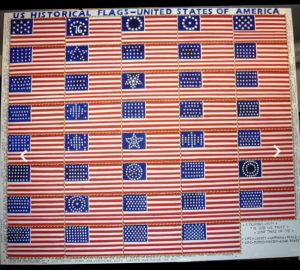 some people silly. Our nation knows that if one right is taken away, it opens a door for others to be lost as well. Our freedom depends on our insistence to follow the rules laid out before us…like them or not. As a patriot, I understand that, but I also wish that those who use the freedom to protest, would also realize that in burning the flag, they are, in essence, saying that they don’t think that we should have the very freedoms they use to protest. It is really a vicious circle when you think about it. They are fighting, and burning a flag, in an effort to have the freedom to do what they want, but in doing so, they are saying that they don’t respect the nation that made that very thing possible for them. What a strange idea!
some people silly. Our nation knows that if one right is taken away, it opens a door for others to be lost as well. Our freedom depends on our insistence to follow the rules laid out before us…like them or not. As a patriot, I understand that, but I also wish that those who use the freedom to protest, would also realize that in burning the flag, they are, in essence, saying that they don’t think that we should have the very freedoms they use to protest. It is really a vicious circle when you think about it. They are fighting, and burning a flag, in an effort to have the freedom to do what they want, but in doing so, they are saying that they don’t respect the nation that made that very thing possible for them. What a strange idea!
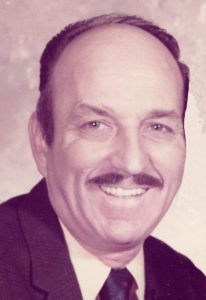
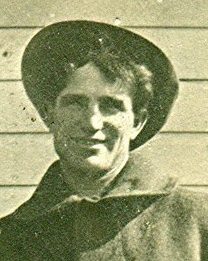 Over the years, I can recall that my dad, Allen Lewis Spencer had a number of hammers, of differing handles and sizes…like most men do, but for as long as I can remember, one hammer was always there. It wasn’t that this hammer was made of gold, or even looked fancy. It had a plain handle, but I suspect it is a hardwood, and not a simple pine. The handle is a medium toned wood, but it may have darkened with age and use. It also has a scorch mark about five inches long along one side, that happened when it was laid a little too close to a campfire. Dad rescued it just in the nick of time. He had to save it, you see. It wasn’t just any hammer…it was his dad’s hammer, and with his dad’s passing, the hammer was given to my dad.
Over the years, I can recall that my dad, Allen Lewis Spencer had a number of hammers, of differing handles and sizes…like most men do, but for as long as I can remember, one hammer was always there. It wasn’t that this hammer was made of gold, or even looked fancy. It had a plain handle, but I suspect it is a hardwood, and not a simple pine. The handle is a medium toned wood, but it may have darkened with age and use. It also has a scorch mark about five inches long along one side, that happened when it was laid a little too close to a campfire. Dad rescued it just in the nick of time. He had to save it, you see. It wasn’t just any hammer…it was his dad’s hammer, and with his dad’s passing, the hammer was given to my dad.
Most wooden handled hammers don’t have a long handle life. That is probably the main reason that many, if not most hammers are made of metal these days. This wooden handled hammer is different, however. My grandfather, Allen Luther Spencer was a carpenter for the Great Northern Railway. His job was to build and repair seats, trim, walls, and floors…anything made of wood on the trains of the Great Northern Railway. He also made tables and chairs for his own family, and he did it all with that same hammer that my dad inherited upon his passing. Unfortunately, I never knew my grandfather, because he passed away before my parents were married. That leaves my sisters and me with only the stories we have heard from family and my Uncle Bill Spencer’s family history. I do know that while my grandfather’s work might never have been in the caliber of my cousins Gene Fredrick, and his sons, Tim and Shawn, he did make some nice things. What impresses me the most is that any work needing a hammer was done by the same hammer that my dad inherited, and that even after all the use my dad has give the hammer, it is still in 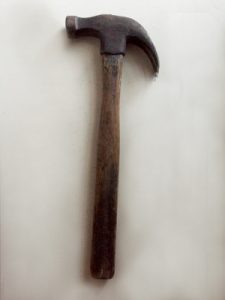
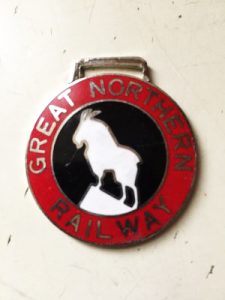 amazing shape. Things were just made well in those days.
amazing shape. Things were just made well in those days.
My dad took great care of that hammer, because it was as much a treasure to him as it is to me. It is so much more than just a hammer, it was my dad’s hammer, and his dad’s hammer. The handle still has the oil from Dad’s hand on it, making that spot darker than the rest of the handle, and I can tell you, that I will not be using the hammer, nor will I clean off that oil, or sand off the scorch mark, or the one little sliver of wood that was torn off of the handle at some point. You see, I think the hammer is just perfect the way it is, and I plan to display it with no changes to it at all, because it was my dad’s hammer, and to me…that makes it priceless.
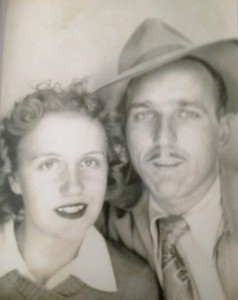 Whenever my sisters and I get together to go through some more of our parents things, I find that the time spent is bittersweet. We enjoy the time together, sharing memories and stories of the past, but there isn’t always regret, because our parents are gone and can’t be there with us. We were always a close family, and as we visit, I can’t help but think just how much Mom and Dad would have loved to be there, listening to the laughter of their girls. As we went through the attic this weekend, there much of the laughter and camaraderie that our parents taught us. They would have been proud of our teamwork, and of course, thrilled with some of the things we found.
Whenever my sisters and I get together to go through some more of our parents things, I find that the time spent is bittersweet. We enjoy the time together, sharing memories and stories of the past, but there isn’t always regret, because our parents are gone and can’t be there with us. We were always a close family, and as we visit, I can’t help but think just how much Mom and Dad would have loved to be there, listening to the laughter of their girls. As we went through the attic this weekend, there much of the laughter and camaraderie that our parents taught us. They would have been proud of our teamwork, and of course, thrilled with some of the things we found.
It had been many years since either of our parents were able to get up in the attic, and Mom couldn’t figure out what had happened to some of the things she felt were precious. If she weren’t in Heaven now, she would know where those treasures had been, and that they had fared well through the years. Now, some of those treasures have been divided up between their girls, and some will be in time. I just wish that we could have found them before Mom passed away, because she always wondered what happened to some of their things. I suppose it happens to most of us, at one time or another. We put something away for safe keeping, and then, we can’t remember where we put it. Mom was right when she said that some of the things were precious, because they were.
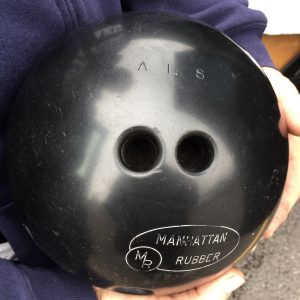
As we planned the weekend’s work, we expected the items in the attic to be mostly junk…old toys, old clothes, and such, and we did find those things, but there were some surprises too. We found more of Dad’s uniforms from World War II, as well as the medals Mom thought had been lost forever. We found her antique sewing machines, and an antique typewriter…yes, the really old style. We found their bowling balls from the years when they bowled, and that made me miss them a lot. I remember all those bowling years, and I suppose that is why I still bowl today. Bowling was their sport of choice, and all of their kids and some of their grandkids bowl too. We made the decision to donate their bowling balls to Sunrise Lanes, so that other people could use them, and enjoy their sport of choice too. I think Mom and Dad would be pleased…I know the employees at the 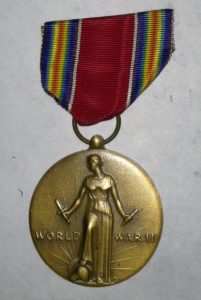
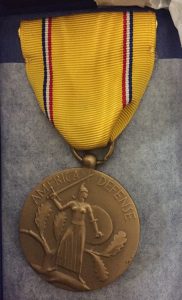 blowing alley were.
blowing alley were.
We also found many pictures, as well as negatives and film. We are excited to have them developed, but dividing them up will be a future get together, because we want them scanned so we can all have copies. We spent a little time looking through the pictures today, and I can tell you that they are precious. Baby pictures, baptismal pictures, baby shower pictures, and many others. I can’t wait to look through those, as well as the love letters Dad sent to Mom…and yes she kept them all tied in a neat little ribbon. Yes, the weekend was an exciting one in many ways, and a sad one in many others, but we would all agree that the treasures found were precious.

